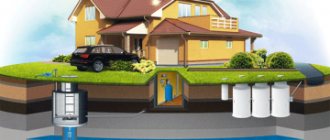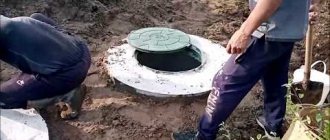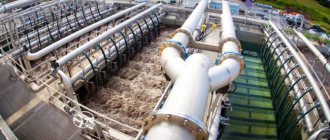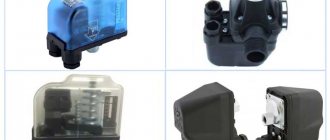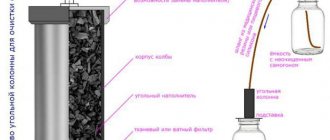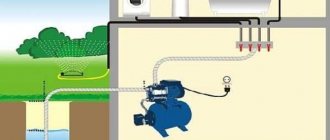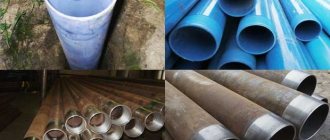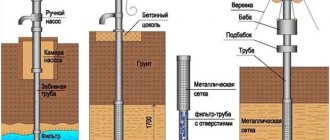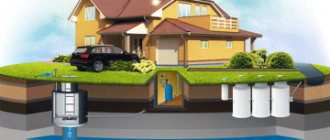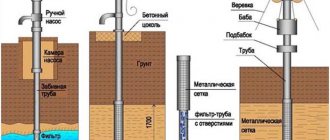Owners of suburban areas where there is no central water supply are forced to look for ways to independently supply their homes with water. The optimal solution is to drill wells into the aquifer. The most productive hydraulic structure is considered to be an artesian well. It is able to provide the house with the necessary amount of clean water. What are the main characteristics, types of structures, service life and operating rules of this type of source?
Let's understand the terminology: what does the name mean?
There is hardly a person who has never heard of an artesian well and that this is one of the best water supply options. An artesian well is a circular opening drilled to reach aquifers with certain properties.
Some underground aquifers lie between impervious layers. Interstratal waters can be non-pressure and pressure; the latter are called artesian. The name comes from the historical region of Artois in northeastern France. Here, since the 12th century, for the first time in Europe, they learned to build gushing wells.
Artesian layers are located in certain geological structures (in depressions, bends, troughs). The depth at which artesian water lies depends on specific geological conditions. Aquifers are formed at different depths, from 100 to 1000 m; for domestic use, sources with a depth of no more than 150-200 m are most often developed.
Diagram of an artesian well Source strojdvor.ru
An artesian aquifer is composed of sedimentary rock: limestone, sand, dolomite or gravel. Water fills voids, cavities and cracks in loose material. The aquifer is enclosed between impermeable layers (usually clay), so the water in it is under pressure.
An artesian aquifer is composed of sedimentary rock: limestone, sand, dolomite or gravel. Water fills voids, cavities and cracks in loose material. The aquifer is enclosed between impermeable layers (usually clay), so the water in it is under pressure.
Water quality
An artesian well provides access to pressurized interlayer water, which is naturally isolated. Clay waterproof layers serve as natural filters, trapping any impurities. Thanks to reliable protection, the water does not mix with surface waters, has a constant chemical composition and high quality.
Often the water in the pressure limestone layer is additionally enriched with salts and microelements and becomes mineral. The content of ferrous impurities or salts may exceed standard values. In this case, the water is purified by filters to make it suitable for drinking.
Subtleties of geology Source moikolodets.ru
Advantages and disadvantages of wells for limestone
This method of providing clean water has several important advantages :
- A durable source of high-quality drinking water with a long service life.
- Uninterrupted supply, independent of season or climate change.
- Interstratal pressure waters have a constant chemical composition, their quality does not suffer from precipitation or human activity.
- The volume of extracted water (from 5 to 20 cubic meters per hour) is enough to supply several farms. It is beneficial for neighbors to unite and lay a common water well.
Disadvantages are considered:
- The large depth of drilling with the use of heavy equipment is the main reason for the high cost.
- To supply water, equipment of increased power is required, which also increases the budget.
- Mineralized water negatively affects pipes and boilers, causing scale formation.
Always nearby Source ecoindustry.ru
- If the source is saturated with salts, it can lead to health problems. In this case, you cannot do without water purification filters.
- Sometimes, due to the unfortunate characteristics of the soil, drilling is delayed for weeks, and sometimes for months.
- It is necessary to obtain a license for an artesian source.
See also: Catalog of companies that specialize in the design and installation of water supply and sewerage
How is a license issued?
The first step is that you provide an application and proof of ownership or a lease agreement.
Further:
- Water consumption is calculated according to standards.
- A conclusion is given on the suitability of the participant for the well. Requirements: plot 60 x 60 (in some cases 30 x 30) without buildings, with fencing.
- A conclusion on the design is given.
- A geological examination is being carried out.
- The well is registered.
Obtaining a license for an artesian well is a paid (and quite expensive) service. The solution and savings lies in the collective use of one well.
Artesian well drilling technology
If you know what an artesian well is, it will be easier to understand the process of drilling it. This is done in two ways :
- Using a large drilling rig based on a truck (for example, GAZ-66 or ZIL-131).
- Using a portable drilling rig. It is chosen if large equipment cannot enter the drilling site.
In practice, several drilling methods are used. The most common is the rotational method with direct flushing; its share is about 90% of all drilling volumes. The process includes the following steps :
- The drilling machine destroys and erodes rock in the working area using specialized tools and drilling fluid. The waste is washed into a special pit.
Portable water drilling rig Source drillingrig.com
- As a result of the operation of the installation, generation is formed. Its diameter exceeds the diameter of the casing pipes by 40-50 mm.
- When the excavation reaches the aquifer, casing pipes are lowered (planted) into the well, connecting them into a column.
- When casing, pipes with threaded connections are used. They come in metal or plastic. Casing is needed for two reasons: it prevents the well from crumbling and prevents contamination by groundwater.
- A drill head with a smaller (30-50 mm) diameter is lowered into the prepared column. It opens the aquifer and flushes the well with clean water.
- The owner is invited to lift the drill rods to measure the depth of the well. Drill rods are hollow equipment that serves to transmit rotation and at the same time supply drilling fluid.
- The rest of the equipment, filters, and pump are being installed.
Heavy equipment Source puls-rf.ru
Can I do it myself?
With such costs, many people naturally wonder whether it is possible to make an artesian well with their own hands. In principle, this is possible when drilling to a depth of no more than 50-60 m and the presence of pliable soil.
To do this, you will need a tripod, a winch and a drilling tool in the form of an auger. A tripod with a winch is installed above the drilling site and ensures the lowering and raising of the tool. Rotation is done manually. The process can be mechanized by using an electric motor or pneumatics.
An artesian well is a rather complex hydraulic structure. You can build it yourself, but it will be limited in depth. Reliable and durable design is provided by specialized organizations with special equipment.
When planning construction, it is important to take into account the need to comply with legislation regarding licensing the use of groundwater. Such a well is expensive, but it will provide a complete, high-quality water supply for a long time.
Drilling parameters
In many cases, only an artesian well can provide a site with water; how many meters its depth will be is not an idle question, it largely determines the final cost of the work. The peculiarity of aquiferous limestones is that they occur unevenly.
Closer to the surface, at a depth of 20-40 m, non-pressure interstratal waters lie. The depth of pressure sources in the Russian Federation reaches 200-250 m. Before work begins, the depth of the well is estimated approximately; the exact number can be found out only after drilling.
There are several characteristics of an artesian well; except for the question
how many meters it will go deep, its diameter and the method of drilling are important. For industrial needs, a diameter of 219-325 mm is chosen, which depends on the productivity and depth, well and pump characteristics.
The diameter of the well for the private sector is determined by the parameters of popular domestic deep-well pumps. Their diameter rarely exceeds 102 mm, so a well with a pipe diameter of 127-159 mm is drilled for them.
Drilling near the house Source izion.pro
Manufacturers offer pumps with a smaller diameter, no more than 50-76 mm, which can be installed with pipes with a diameter of 76 mm or more. At first glance, this option seems profitable, as it allows you to save money. In fact, such devices are ineffective, and those that provide pumping in the required volume are prohibitively expensive. Also, do not forget that small-diameter wells, as a rule, cannot be repaired.
TO WHAT DEPTH CAN A WELL BE DRILLED?
WITHOUT PERMISSION OR LICENSE?
The depth of a water well is not an idle question and depends on many factors. First of all, you need to decide what water is needed for and in what quantities. It’s one thing if the water is intended to be used only for household needs, such as watering a garden in a personal plot or washing dishes. For this purpose, water is taken from high-water layers with a shallow depth. For such situations, a well permit is not required; you can drill yourself.
At the same time, before starting work, you need to make sure that there is water on the site, and the depth of its occurrence allows you to drill a well with a guarantee of success! Even the presence of a full-flowing well on a neighboring site does not mean anything!
WHAT DOES THE DEPTH OF DRILLING A WATER WELL DEPEND ON?
Groundwater is considered a mineral, and its use is regulated by the Law of the Russian Federation of 02/21/1992 N 2395-1 (as amended on 08/03/2018) “On Subsoil” (as amended and supplemented, entered into force on 01/01/2019). In 2014, important amendments were made to the law.
The old version of the law limited the use of groundwater to the first aquifer. Moreover, it should not have been a source of centralized water supply. Now it is possible to use groundwater from any aquifers located above aquifers that are sources of centralized water supply.
The current version of the law states: “Owners of land plots, land users, landowners, tenants of land plots have the right to use, within the boundaries of these land plots, without the use of blasting, for their own needs ... groundwater, the volume of extraction, which should be no more than 100 cubic meters per day, from aquifers that are not sources of centralized water supply and located above aquifers that are sources of centralized water supply, as well as the construction of underground structures to a depth of up to five meters in the manner established by laws and other regulatory legal acts of the constituent entities of the Russian Federation.”
That is, obtaining a license for a well that meets the listed requirements (the extraction volume is no more than 100 cubic meters per day and from aquifers located above aquifers - sources of centralized water supply) is not necessary.
It also follows from the law that water from a well can be used by the owner or tenant of the plot on which the well is located. If a well is being built in several areas, a license is already required; If you plan to use groundwater in business activities, you will also need to obtain a license; The law prohibits selling (or transferring to someone) water extracted on your site for your own needs - for this you also need to obtain a license for the extraction of groundwater; For your own needs, you can extract no more than 100 cubic meters per day.
But this is more than enough even for the needs of a large private household plot. For the extraction of groundwater from aquifers that are not sources of centralized water supply, a license, according to Article 19 of the Law “On Subsoil”, is not required. And usually these are sandy horizons that are not suitable for drilling powerful wells. The law does not say a word about the depth of wells for this first aquifer; the main thing is that it should not be a source of centralized water supply. But sometimes such sandy horizons have very good water yield, and they are used to supply water to the entire village or gardening community. Should such a horizon be considered a source of centralized water supply with all the ensuing consequences?
A centralized system serves to supply water to subscribers. If the circle of people is limited, or, on the contrary, there are no restrictions at all, not even theoretical ones (general access), then this is not a centralized system. Therefore, a partnership can have either a centralized water supply system (if new subscribers can connect to it) or a non-centralized one (if, for example, they created a network only for members of the partnership and no one else).
WELL PRODUCTION:
This indicator may even be the main one when determining tactics for searching for water. With a small volume of water consumption and its predominantly economic purpose, it is enough to go to the upper water layer “quicksand” with a flow rate of 0.5 m3/hour to a depth of 2 to 5 meters. Such a well will cost a minimal amount, especially if you drill it yourself. It does not require registration, since the Subsoil Law does not include the first aquifer layer in the composition of minerals.
But there is a risk of being left without water during a drought, since in a hot, dry season such a well or well “on quicksand” can dry up. To obtain permission to drill wells, you need to spend an amount of 70 to 300 thousand rubles just on paperwork.
A small station for deferrization, biological and chemical water purification will definitely cost less, but with guaranteed quality. In some areas, the depth of the aquifer reaches 20 meters. Regulatory authorities, knowing the geological features of the area, often simply turn a blind eye to wells 15–20 meters deep, or local authorities make a special decision on the free operation of such water intakes.
IS IT POSSIBLE TO DRILL AN ARTESIAN WELL ON THE SITE?
(WELL FOR LIMESTONE)
Almost all artesian aquifers are sources of centralized water supply. Citizens are massively drilling wells “for limestone,” but there is no legislative act that would allow private individuals to drill artesian wells. A citizen of the Russian Federation (not in the status of an individual entrepreneur) does not have the right to drill (order drilling) for limestone on his personal plot. This follows from the federal law “On Subsoil”, since in physical a person cannot be issued a license to use subsoil. Drilling companies also commit crimes by drilling wells into limestone for private individuals. Water production in a volume of less than 500 m³/day. regulated by local authorities, usually within the competence of the regional Ministry of Ecology and Natural Resources.
Groundwater extracted on the site should not be extracted from aquifers that are sources of centralized water supply. Therefore, in order to drill a well on your site and not violate the law, you need to know for sure whether you have a source of centralized water supply on your site or not. But this information is not available in open sources.
Having drilled an artesian well to a depth of 80 meters, you may well encroach on someone’s subsoil plot (water reserves in which are on the state balance sheet), for example, some water utility, the water intake of which may be several kilometers from your water supply. The fact is that an underground lake or other underground water body can occupy a huge area. If it has been explored and is on the state balance sheet as an existing or potential source of centralized water supply, then it is impossible to drill a well and extract water from it.
Before amendments to the law, it was enough to obtain a conclusion that water was extracted from the first aquifer (a priori it was believed that this was not a source of centralized water supply). The new version does not mention the first aquifer.
In some cases, under pressure from circumstances, the Ministry of Natural Resources gives the owner of the site a license to use an artesian water intake (when there are simply no other water supply options). But even then you will have to overcome a number of restrictions. To obtain a license, the owner of the plot must: Present a document confirming ownership of the land (or a lease agreement).
Order a calculation of water consumption from specialists and have it approved by the appropriate authority (in the Moscow region this is the water resources department for the Moscow region of the Moscow-Oka Basin Water Administration of the Federal Water Resources Agency).
Obtain a conclusion from Rospotrebnadzor that the site is suitable for organizing a sanitary zone. This point seems practically impossible to implement: according to the requirements of paragraph 2.1.4.1110-02 SanPiN, sanitary protection zones must be 60x60 m.
Obtain a conclusion on the design of an artesian well (in the Moscow region - from the territorial Center for State Monitoring of the Condition of Subsoil of the Federal State Unitary Enterprise "Geocenter-Moscow").
Rospotrebnadzor must check the quality of water in the finished artesian well, and then it must be registered with the state, a sanitary protection zone must be built, and a state geological examination must be carried out. The process, frankly, is not simple, not fast and not cheap.
TAXATION FOR WELL USE
As regulated by the “Law on Subsoil”, registration of wells from the first aquifer layer on sand is not mandatory, therefore, the use of such water intake is not subject to tax, be it a well or a well. So why is well registration required? For each registered well, a license is issued, which certifies the owner’s right to carry out geological exploration work and operate a water intake for water production.
This document states:
passport details of the well owner;
data on the target content of the work being carried out;
name of the government agency that issued the license;
boundaries of the territory in the area where a well can be drilled;
permitted level of extraction of life-giving moisture;
terms of payment for the use of subsoil;
Someone might think that no one will figure out from what level water is extracted, but this is far from the case - Rosgeomonitoring specialists easily determine the main parameters of water intake. So, it is better to register the well in the prescribed manner and sleep peacefully.
Violation of the requirements of the subsoil law is fraught with a fine: For individuals - in the amount of 3,000 - 5,000 rubles; For managers of enterprises and organizations in whose name the operating well is registered (or not) – 30 – 50 thousand rubles.
For the same violation by a legal entity - 800 - 1000 thousand rubles. It is necessary to clarify that the material damage caused must be compensated by the offender in full. Here, material losses cannot be compared with fines.
The only type of water intake that never raises doubts about its compliance with the requirements for free use of water is the Abyssinian well. Due to the design features and the method of drilling such a water intake, it is always fed by perched water, regardless of the depth of the trunk. At the dacha, especially if the Abyssinian well is built right in a private house, this is the most convenient method of extraction, given that it does not require electricity. It does not require registration, it can be used in any conditions constantly or periodically.
In addition to imposing a fine, you can receive a decision to liquidate the water intake device. Inspectors have the right to request from the owner the following documents for water intake at the site:
DOCUMENTS FOR WATER INJECTION:
Well passport, documents that confirm compliance with the license requirements, a log of periodic measurements of dynamic and static levels, tax payment receipts, confirmation from Sanitary and Epidemiological Supervision on the correct organization of the sanitary water intake zone, cadastral registration documents for the well, results of analysis of fluid samples from the well, agreed limits on the amount allowed water intake, a journal in which liquid consumption is recorded, copies of consumption declarations that are submitted to the tax authority.
GRADATION OF WATER INJECTION DEPTH
Most owners of country estates, when planning to drill and register a well, are not aware of the state gradation of depths and what consequences this implies. Typically, all wells are subject to registration with government organizations, and a water tax is charged for the use of the earth’s subsoil; the amount of payment depends on the depth of water intake. The permitted depth of a well in its area does not imply the use of unique subsoil and ranges from 5 to 20 meters, but in some places it can go to a depth of 35 - 40 meters, which depends on the hydrogeology at the place where the work is performed.
The drilling depth always depends on the chosen execution method; an approximate scale can be presented as follows: from 6 meters for upper horizons to 11 meters, for sandy horizons up to 17 meters when drilling on gravel sands, and from 15 to 45 meters depth when drilling on medium sands.
Deep wells from 150 meters are drilled to reach artesian horizons. Possible wells for limestone from 10 m and only in the Moscow region.
What depth to choose is the owner’s decision, but the amount of tax to be paid will depend on this decision.
DETERMINING THE TYPE OF WELL:
To select the type of water intake, it is necessary, first of all, to determine the maximum daily water requirement for the needs of the facility.
CALCULATION OF CONSUMPTION:
To do this, you need to consider:
the need for watering the garden and lawn per day;
expenses for household needs, taking into account the use of equipment - washing machine, dishwasher, etc.;
need for hygiene procedures - shower, bath, washbasins, toilets;
other expenses – cleaning of premises, vehicle washing, heating;
In this way, it is possible to determine the maximum consumption in terms of cubic meters per hour, which can never be reached.
Followed by:
EXPLORATION DRILLING:
For this operation, it is better to resort to rotary drilling with hydraulic flushing, as the most productive method that allows you to simultaneously control the quality of soils by studying the washed-out rock. Control of penetration should begin from a depth of 2 meters, since this is the most likely depth for the appearance of signs of an aquifer!
Drilling a water well, carried out by your invited team using any type of equipment, will be EXPLORATION DRILLING until the first aquifer is discovered and a decision is made to install a casing pipe to this horizon or to continue further EXPLORATION DRILLING FOR WATER due to the weak water yield of the already explored aquifer. The average cost of such drilling in Russia is set in the price range of 800 - 1000 rubles. per meter of penetration.
DO YOU HAVE ANY QUESTIONS?
8-980-654-0036
Features of operation
A free-flow sand well is designed for an average service life of 5-7, rarely more, years. Unlike a sand well, an artesian well with a depth of 100 m or more is characterized by a high degree of reliability. Sources from such depths have been exploited for 40-50 years. The service life depends on the depth and pressure of the aquifer being opened; The following options are possible :
- Wells drilled into an aquifer close to the surface operate for no more than 25-30 years. Shallow springs silt up and therefore require repair work every 7-10 years.
Cleaning from siltation Source global-bur.ru
- A free-flow well on limestone will last 20-30 years. The service life can be significantly extended if a two-pipe design is used.
- An artesian well for deep sand will work for 20-25 years, if you do not violate the operating rules.
Well life will be reduced if:
- Do not install a well filter when the aquifer rocks are mobile.
- Install a pump that exceeds the capacity of the aquifer. This may lead to filter failure.
- Violate the maximum water withdrawal limit.
Installation of a deep-well pump Source bitrix24.ru
Types of designs
Classic well design
To construct such a well, one metal casing pipe is required, which also serves as a production pipe. It is possible to drill a well without additional pipes if there are no clay and sand layers in the limestone. A pipe is used before the beginning of the limestone layer, and the last drilled section of the well to the aquiferous limestone does not require casing, since deformations are unlikely. The optimal pipe diameter in a single-pipe design is 159 or 133 mm. In the classic well design, the water rises to the middle and slightly higher, so the pump is installed at the end of the casing.
Single-pipe artesian well
Well with double casing
This design involves the presence of additional casing in the dry limestone area. A metal pipe is installed up to the limestone layer, and then a plastic pipe of a slightly smaller diameter is pushed into it, which passes through the entire limestone to the aquifer lens.
Double pipe design
Artesian well with conductor
If the soil surface is replete with quicksand, then a conductor is needed in front of the casing. This is essentially a pipe with a slightly larger diameter than the casing, which is placed on top and protects the casing from excessive pressure.
Well with conductor
If, when constructing an artesian well, you are going to make a caisson, then the conductor can be very successfully combined with the walls of the caisson.
Artesian well with telescopic design
This well uses two or more casings. This is done in case of instability of the soil above the limestone layer. The structure was dubbed telescopic because initially the widest metal casing pipe, which ends in a layer of boulders, is lowered into the drilled well. Another one is passed into it before the limestone, also made of metal, but with a smaller diameter. If layers of clay are noticed, then a third one is inserted into the second pipe - made of plastic, which already reaches the water.
What does the cost depend on?
To drill a well for water from an artesian aquifer, on average it takes 5-7 days. The cost of an artesian well for limestone, carried out on a turnkey basis, exceeds the cost of a source from a shallow, non-confined sandy horizon.
The high cost is justified by long service life and gradual payback. The following reasons influence the final price :
- Due to the great depth, drilling is characterized by increased complexity; heavy drilling equipment is used.
- A deep source requires a larger mine diameter and more casing pipes. This increases the cost of drilling and payment for drilling work.
- Deep burial requires the use of high-quality materials that can last for decades.
- The estimate increases if there is a need for additional work. Thus, when casing a well, annular cementation is sometimes carried out.
PVC casing pipes Source o-trubah.ru
↑ That's it. There are no further jokes. Only information for those who decide to work with us
As you already understand, we are not the last people to drill water wells.
Thanks to the hydrogeological and hydrogeochemical studies carried out, it was possible to theoretically substantiate the concept of an aquifer as a complex geological formation, which allowed our employees to develop, test and implement into everyday practice the “Technology for searching and hydrogeochemical research of thin aquifers”.
This is what we use in the construction of water intake wells, which helps to identify and select the cleanest and safest water for health.
The technology is based on the use of standard high-quality casing pipes and carbide bits.
- Outer diameter – 127 mm.
- The type of casing connection is threaded.
- Thread type: tape.
- Casing pipe material is steel 20 or steel 45.
- Pipe wall thickness is 5 or 6 mm.
- Crown type - KT 2
We have been engaged in hydrogeochemical research for several years and therefore have some idea of the distribution of certain waters, both over the territory and in depth.
We responsibly declare: the total mineralization of natural waters, with extremely rare exceptions, increases exponentially with depth. In other words, the deeper, the worse.
.
The most valuable waters, from the point of view of hydrogeochemistry, are concentrated near the surface. And if it weren’t for the notorious “human factor”... If only.
Therefore, when constructing water intake wells, we focus on the most protected waters closest to the surface.
Unfortunately, in the south of the Leningrad region there are entire areas where, due to geological reasons, at reasonable depths, one cannot expect the appearance of waters that at least closely correspond to GOST. We can only talk about waters that have greater or lesser mineralization.
Due to our professional interest, we compulsorily conduct a chemical analysis of water from our wells, assessing it according to 26 parameters, identifying, among other things, the presence of such unpleasant substances as hydrazine, cyanuric acid, cyanide, and fluorine. Details in the section “Hydrogeochemical studies”. It is best to sample water for chemical analysis 2-3 weeks after the construction of a well, since it takes time for an oxide film to form on the surface of steel pipes under the influence of oxygen dissolved in water. After 2-3 weeks, the impact of the casing pipe material practically ceases to affect the chemical composition of the water.
The technology we use allows us to continue drilling a well at any time if the water of the identified aquifer suddenly turns out to be unsuitable for use.
Upon completion of the work, we issue a well passport, which summarizes information about the technological and design solutions applied (drilling diameters, casing intervals, etc.); hydrogeodynamic characteristics of the production formation are given; lithological column; protocol for determining the chemical composition of water; recommendations on the use of pumping equipment and measures to protect water from pollution.
We try to build good relationships with all our clients, and for many years we have been monitoring wells, periodically sampling water for chemical analysis, which will always be free for you.
Due to professional interest, we are vitally interested in the long-term operation of your well. That’s why we don’t even stipulate the warranty period for the work performed.
Briefly about the main thing
They learned to extract water from artesian formations many centuries ago. The method has become publicly available; it is used in places where aquifers lie in the desired geological structure, at a depth accessible to specialized drilling rigs.
Water from artesian sources flows uninterruptedly, is clean and has a constant chemical composition. Depending on the depth of the site, heavy equipment or a portable drilling rig is used for drilling. The exact depth can only be determined after raising the drill rods.
Wells with different depths have different service lives and are operated differently. Their cost is influenced by the volume and cost of drilling, the choice of materials, and the need for additional work.
Ratings 0
How to find out the depth of a well for your locality
The website has an interactive depth map.
You can use this map to determine the approximate depth of a well in an area. Our map is compiled using the Yandex maps service engine.
How to properly use the interactive map on the website:
- Enter the territory's address into the search form in the upper left corner.
- Click on the "Find" button. The object should appear in the center of the map.
- If your village is not yet on the map, enter the nearest known address.
- Move the map with your mouse to find the nearest sources and find out their parameters.
- Use the "+" and "-" buttons to zoom in or out on the map.
Based on the level of water in nearby areas, you can estimate the approximate depth for your territory. But the method does not provide one hundred percent accuracy. The differences in the occurrence of the aquifer in neighboring areas can reach a couple of tens of meters.
Buden is interested: How to check the depth of a well after drilling.
